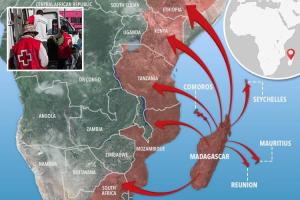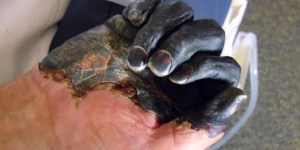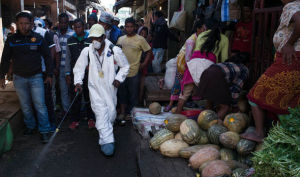nsnbc : Nine African countries have been put on alert after an outbreak of bubonic plague in Madagascar. The island is facing a worrying spread of the deadly disease, with 124 people killed by last week already and a total of more than 1,133 people who have been registered as infected across the country. The World Health Organization warns that there is a high risk that the disease will spread to other countries.
The outbreak of the disease has so far been self-contained in Madagascar, while South Africa, Mauritius, Seychelles, Tanzania, La Réunion, Mozambique, Kenya, Ethiopia and Comoros have all been put on notice. The World Health Organization (WHO) stressed that special attention should be paid to preventing the spread of the disease to international holiday hotspots because containment and preventing a global spread of the disease, also called “the black death” for the black color of extremities in advanced stages. South Africa is among the British holiday hotspots identified by the World Health Organisation as priority countries to get ready to defend against the bubonic plague.
UNICEF, the Red Cross, the Centers for Disease Control and Prevention (CDC) and the European Centre for Disease Prevention and Control (ECDC) have mobilized emergency plans in the countries with the aim to increase public awareness to increase surveillance, particularly at borders, draw up contingency plans and sourcing medication. In WHO’s update on the outbreak, the UN body said:
“Nine countries and overseas territories have been identified as priority countries in the African region for plague preparedness and readiness by virtue of having trade and travel links to Madagascar. … WHO is prepositioning equipment and supplies, including personal protective equipment, antibiotics and other equipment required to safely identify plague cases, in Comoros, Mauritius, Mozambique, Seychelles, and Tanzania. … Due to the increased risk of further spread and the severe nature of the disease, the overall risk at the national level is considered very high. The risk of regional spread is moderate due to the occurrence of frequent travel by air and sea to neighboring Indian Ocean islands and other southern and east African countries, and the observation of a limited number of cases in travelers.”
 The bubonic plague has a 30 to 100 per cent chance of death if left untreated. Elhadj As Sy, secretary-general of the International Federation of Red Cross and Red Crescent Societies, said: ”The number of cases is growing by the day. “Our volunteers are working in communities convincing people to seek help.”
The bubonic plague has a 30 to 100 per cent chance of death if left untreated. Elhadj As Sy, secretary-general of the International Federation of Red Cross and Red Crescent Societies, said: ”The number of cases is growing by the day. “Our volunteers are working in communities convincing people to seek help.”
Plague symptoms include sudden fevers, head and body aches, vomiting and nausea. Bubonic plague, the most common form of plague, can causes inflamed lymph nodes, which can then turn to puss-filled, open sores if the condition worsens. It can develop to pneumonic plague, if the infection spreads to the lungs. The bubonic plague is transmitted to humans by infected fleas.
The majority of those reported by WHO had developed to pneumonic. People in affected countries are advised to do everything in their power to prevent contact with rats and rat-infested dwellings and areas, to treat pet animals and homes against flees, avoid unnecessary contact with farm animals who could be flee-infested, and to seek medical help at the first sign of possible symptoms.
 The Mozambican Ministry of Health reported that it is drawing up a plan to respond to any possible outbreak of bubonic plague, following the outbreak in Madagascar which has affected about 100,000 people and has caused over 100 deaths. Assistant National Director of Public Health, Maria Benigna Matsinhe told reporters, work is under way to control the entry points to the country to check and follow-up any person who has been in Madagascar.
The Mozambican Ministry of Health reported that it is drawing up a plan to respond to any possible outbreak of bubonic plague, following the outbreak in Madagascar which has affected about 100,000 people and has caused over 100 deaths. Assistant National Director of Public Health, Maria Benigna Matsinhe told reporters, work is under way to control the entry points to the country to check and follow-up any person who has been in Madagascar.
Speaking on Friday at the ceremony to launch National Health Week, Matsinhe said “even before there were indications that our country is at risk, as soon as we knew of the Madagascar outbreak, the Health Ministry organized, and sent guidelines to the provinces to strengthen vigilance at the borders”. Health workers are observing people who enter the country, and noting where they have been, she said. If they have visited Madagascar, they are screened. “We know that the symptoms of plague are fever and a feeling of malaise, which in some cases can evolve to pneumonia”, she said. “Our workers at the entry points are prepared.
Mozambique already has experience of dealing with plague, since there have been repeated outbreaks in Mutarara district, in the western province of Tete, on the border with Malawi. The latest such outbreaks were in 1994 and 1997. Three deaths were reported in 1994 and none in 1997. The sporadic appearance of plague in Mutarara and in southern Malawi is likely to indicate a reservoir of the bacteria among the wild rodent population.
A/N – nsnbc 30.10.2017
Source Article from https://nsnbc.me/2017/10/30/african-countries-alert-outbreak-bubonic-plague-madagascar/
 RSS Feed
RSS Feed















 October 30th, 2017
October 30th, 2017  Awake Goy
Awake Goy 











 Posted in
Posted in  Tags:
Tags: 













